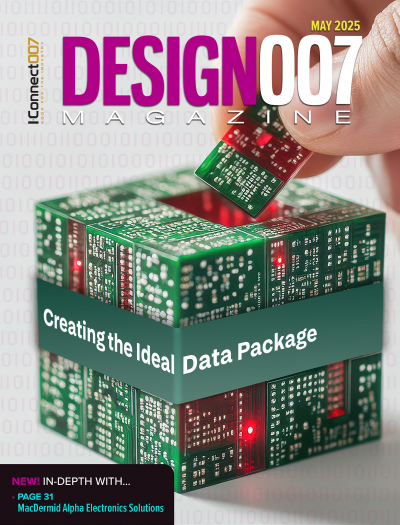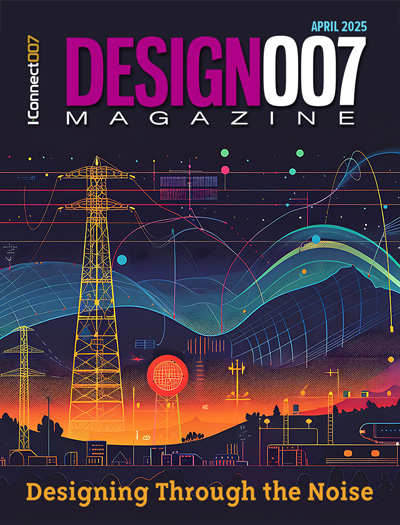-

- News
- Books
Featured Books
- design007 Magazine
Latest Issues
Current Issue
All About That Route
Most designers favor manual routing, but today's interactive autorouters may be changing designers' minds by allowing users more direct control. In this issue, our expert contributors discuss a variety of manual and autorouting strategies.

Creating the Ideal Data Package
Why is it so difficult to create the ideal data package? Many of these simple errors can be alleviated by paying attention to detail—and knowing what issues to look out for. So, this month, our experts weigh in on the best practices for creating the ideal design data package for your design.

Designing Through the Noise
Our experts discuss the constantly evolving world of RF design, including the many tradeoffs, material considerations, and design tips and techniques that designers and design engineers need to know to succeed in this high-frequency realm.
- Articles
- Columns
- Links
- Media kit
||| MENU - design007 Magazine
Why We Simulate
April 29, 2021 | Bill Hargin, Z-zeroEstimated reading time: 1 minute
When I was cutting my teeth in high-speed PCB design some 25 years ago, speeds were slow, layer counts were low, dielectric constants and loss tangents were high, design margins were wide, copper roughness didn’t matter, and glass-weave styles didn’t matter. We called dielectrics “FR-4” and their properties didn’t matter much. A fast PCI bus operated at just 66 MHz.
As speeds increased in the 1990s and beyond, PCB fabricators acquired software tools for designing stackups and dialing in target impedances. In the process, they would acquire PCB laminate libraries, providing proposed stackups to their OEM customers late in the design process, including material thicknesses, copper thickness, dielectric constant, and trace widths—all weeks or months after initial signal-integrity simulation and analysis should have taken place.
Speeds continued to increase in the 2000s; design margins continued to tighten, and OEM engineers began tracking signals in millivolts (mV) and picoseconds (ps). Figure 1 illustrates these trends starting in 2000, emphasizing the trajectory of PCI Express trajectory, from PCIe 3.0 in 2010 to PCIe 6.0, which is just on the doorstep.
In webinars and training events I often pose this question: “Why do we simulate?” I ask because the answers tell me a lot about the audience, and some wise older person long ago told me and my fellow students to “always know your audience.”
When I ask that, I get answers like faster signaling speeds, calculating impedance or loss, opening eyes and avoiding inter-symbol interference, controlling crosstalk, etc. These are all good answers, but a bit on the periphery in my view.
One astute signal integrity practitioner offered that we simulate for only two reasons:
- To make design decisions (i.e., evaluate tradeoffs during design).
- To verify a design before manufacturing (verification).
The only question that designers really care about is, “Will it work and by how much?” This implies that the simulation should be able to produce tangible metrics that can be related to design success or failure. Fair enough.
This is a good description for “why we simulate,” but so far, I’ve never heard anyone mention the most fundamental reason, in my opinion, for signal integrity (SI) or power integrity (PI) simulation: To predict the negative impact that the physical world has on the electrical world, and to mitigate or prevent the negative effects proactively.
To read this entire article, which appeared in the April 2021 issue of Design007 Magazine, click here.
Suggested Items
The Evolution of Picosecond Laser Drilling
06/19/2025 | Marcy LaRont, PCB007 MagazineIs it hard to imagine a single laser pulse reduced not only from nanoseconds to picoseconds in its pulse duration, but even to femtoseconds? Well, buckle up because it seems we are there. In this interview, Dr. Stefan Rung, technical director of laser machines at Schmoll Maschinen GmbH, traces the technology trajectory of the laser drill from the CO2 laser to cutting-edge picosecond and hybrid laser drilling systems, highlighting the benefits and limitations of each method, and demonstrating how laser innovations are shaping the future of PCB fabrication.
Day 2: More Cutting-edge Insights at the EIPC Summer Conference
06/18/2025 | Pete Starkey, I-Connect007The European Institute for the PCB Community (EIPC) summer conference took place this year in Edinburgh, Scotland, June 3-4. This is the third of three articles on the conference. The other two cover Day 1’s sessions and the opening keynote speech. Below is a recap of the second day’s sessions.
Day 1: Cutting Edge Insights at the EIPC Summer Conference
06/17/2025 | Pete Starkey, I-Connect007The European Institute for the PCB Community (EIPC) Summer Conference took place this year in Edinburgh, Scotland, June 3-4. This is the second of three articles on the conference. The other two cover the keynote speeches and Day 2 of the technical conference. Below is a recap of the first day’s sessions.
Preventing Surface Prep Defects and Ensuring Reliability
06/10/2025 | Marcy LaRont, PCB007 MagazineIn printed circuit board (PCB) fabrication, surface preparation is a critical process that ensures strong adhesion, reliable plating, and long-term product performance. Without proper surface treatment, manufacturers may encounter defects such as delamination, poor solder mask adhesion, and plating failures. This article examines key surface preparation techniques, common defects resulting from improper processes, and real-world case studies that illustrate best practices.
RF PCB Design Tips and Tricks
05/08/2025 | Cherie Litson, EPTAC MIT CID/CID+There are many great books, videos, and information online about designing PCBs for RF circuits. A few of my favorite RF sources are Hans Rosenberg, Stephen Chavez, and Rick Hartley, but there are many more. These PCB design engineers have a very good perspective on what it takes to take an RF design from schematic concept to PCB layout.


